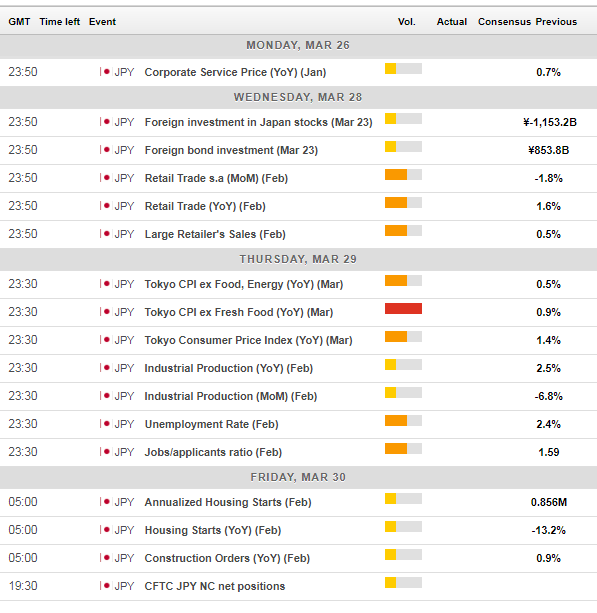- The USD/JPY tumbled down to a 16-month low on trade, geopolitics, and rising US rates.
- The last week of March features several significant indicators, but politics remain central.
- The technical picture sees the pair in oversold territory.
Why the USD/JPY collapsed
The USD/JPY fell to the lowest levels since November 2016 below the ¥105 handle. The main reason is an escalation in trade wars but also other moves had an impact:
1) US-Chinese trade issues: The Trump Administration announced plans to impose tariffs on Chinese goods and also sanction the world's second-largest economy on Intellectual Property. The estimated size of the underlying products is around $50-60 billion, and China was quick to respond, albeit with tariffs limited to approximately $3 billion. The Japanese yen is a safe-haven currency that gains in times of trouble and the sharp losses in stock markets indicate these are times of crisis.
2) No exemption for Japan on metals: The previous tariffs by the Trump Administration on steel and aluminum came into effect. Many countries received an exception but not Japan. This is another source of worry.
3) A hawk as National Security Adviser: Trump also announced the replacement of H.R. McMaster with John Bolton as National Security Adviser. This latest reshuffle puts a hawk that supported the Iraq war at a top-level position. The US approach towards North Korea could harden adding to the safe-haven flows.
4) US rate hike: The Fed raised the interest rates to a maximum of 1.75% as widely expected and is set to continue increasing rates later on. Jerome Powell and his colleagues did not raise the projection for hikes in the dot-plot for 2018 and were disappointed by the slow rise in wages. On trade, Powell mentioned that businesses had voiced concern. If things continue deteriorating, the Fed may slow down the pace of hikes.
The US did enjoy some positive data that helped it recover towards the end of the week. Durable Goods Orders rose by 3.1%, around double the expectations and Core Orders were up 1.2%, far better than 0.5% projected.
US events: Final GDP, consumer confidence, and politics
Politics will likely remain left, right and center. The trade story is far from over, and things could go in any direction. A defusing of the situation with some kind of deal between China and the US on the new tariffs and an exemption to Japan on steel and aluminum would drive the pair higher. A further escalation, especially between China and the US, may send the pair further down.
Comments by the new NSA John Bolton about North Korea and perhaps another White House shakeup could also shake the safe-haven yen.
After the Fed decision, we will hear from several Fed officials ahead of Easter. On Monday, Bill Dudley and Loretta Mester will speak. Dudley is the outgoing President of the New York Fed, and he may provide react to the decision, trade, and other topics. Mester is known as a hawk. The Atlanta President Raphael Bostic will talk on Tuesday, and he is more of a dove.
Significant data comes only on Wednesday: the final read of Q4 GDP is expected to show a small upgrade: an annualized growth rate of 2.6% after 2.5% in the second read. The composition of growth will also matter. Markets prefer more consumption and exports and less government spending and inventories.
On Thursday, the US publishes the Fed's favorite inflation measure: the Core PCE Price Index for February. It is expected to remain unchanged at 1.5% YoY while rising at a monthly pace of 0.2% MoM, slower than 0.3% reported for January. This implies a mimicking of the Core CPI figures published in mid-March.
The publication is accompanied by Personal Income, Personal Spending, and Jobless Claims. A speech by Fed Patrick Harker of the Philadelphia Fed will be the last meaningful event. Friday is Good Friday, and most of the world enjoys the Easter holiday.
Here are the top US events as they appear on the forex calendar:
Japan: Fiscal year end and a verbal intervention from a weak government?
Japan's fiscal year ends at the end of the first quarter, the end of March. This may trigger last moment adjustments by portfolio managers and scrambles to balance the books. Volatility may be higher than usual.
The Japanese authorities do not like a strong currency and may try to talk the Japanese Yen down. The Ministry of Finance is responsible for interventions, and the Bank of Japan implements them. However, the Minister of Finance, Taro Aso, is in a delicate position amid the Moritomo scandal. He is implicated in the falsification of documents. The government is not under threat at the moment, but the weakened position means an intervention, verbal or real, may be hard to pull off.
There are also quite a few indicators released in Japan. Retail trade data is published late on Wednesday, but the most important release comes on Thursday (Friday morning in Japan) when the updated inflation data for Tokyo is published. The capital region publishes the Consumer Price Index for the current month of March. Prices excluding food rose by 0.9% in February, and a similar figure is likely now.
Here are the events lined up in Japan:
USD/JPY Technical Analysis: Near oversold territory
The USD/JPY is undoubtedly in a downtrend. It is capped by downtrend running since the beginning of the year. A more moderate downtrend is forming as support.
Momentum is strong to the downside, and the RSI is also quite significant and nearing oversold territory, just above the 30 level.
There are very few lines of support to the downside after the big break with ¥104.62 serving as the initial place the pair stopped at.. ¥103.10 provided support t the pair back in September 2016. Below, ¥102.55 was a support line in October of that year.
Looking up, the previous low of ¥105.25 is noteworthy. It is followed by ¥105.55, the mid-February low. The March 21st high of ¥106.60 is the next level to watch.
What's next for USD/JPY?
The pair is falling for good reasons, but markets tend to overreact. And while the Japanese government may find it hard to talk down their currency and Trump may further escalate his moves, the pair may bounce from near oversold levels before resuming its downtrend.
Examining the FXStreet FX Poll shows a bearish bias in the near term and a bullish one later on, contrary to the opinions expressed here.
Information on these pages contains forward-looking statements that involve risks and uncertainties. Markets and instruments profiled on this page are for informational purposes only and should not in any way come across as a recommendation to buy or sell in these assets. You should do your own thorough research before making any investment decisions. FXStreet does not in any way guarantee that this information is free from mistakes, errors, or material misstatements. It also does not guarantee that this information is of a timely nature. Investing in Open Markets involves a great deal of risk, including the loss of all or a portion of your investment, as well as emotional distress. All risks, losses and costs associated with investing, including total loss of principal, are your responsibility. The views and opinions expressed in this article are those of the authors and do not necessarily reflect the official policy or position of FXStreet nor its advertisers. The author will not be held responsible for information that is found at the end of links posted on this page.
If not otherwise explicitly mentioned in the body of the article, at the time of writing, the author has no position in any stock mentioned in this article and no business relationship with any company mentioned. The author has not received compensation for writing this article, other than from FXStreet.
FXStreet and the author do not provide personalized recommendations. The author makes no representations as to the accuracy, completeness, or suitability of this information. FXStreet and the author will not be liable for any errors, omissions or any losses, injuries or damages arising from this information and its display or use. Errors and omissions excepted.
The author and FXStreet are not registered investment advisors and nothing in this article is intended to be investment advice.
Recommended Content
Editors’ Picks
EUR/USD retreats below 1.0700 after US GDP data

EUR/USD came under modest bearish pressure and retreated below 1.0700. Although the US data showed that the economy grew at a softer pace than expected in Q1, strong inflation-related details provided a boost to the USD.
GBP/USD declines below 1.2500 as USD rebounds

GBP/USD declined below 1.2500 and erased the majority of its daily gains with the immediate reaction to the US GDP report. The US economy expanded at a softer pace than expected in Q1 but the price deflator jumped to 3.4% from 1.8%.
Gold drops below $2,320 as US yields shoot higher

Gold lost its traction and turned negative on the day below $2,320 in the American session on Thursday. The benchmark 10-year US Treasury bond yield is up more than 1% on the day above 4.7% after US GDP report, weighing on XAU/USD.
XRP extends its decline, crypto experts comment on Ripple stablecoin and benefits for XRP Ledger

Ripple extends decline to $0.52 on Thursday, wipes out weekly gains. Crypto expert asks Ripple CTO how the stablecoin will benefit the XRP Ledger and native token XRP.
After the US close, it’s the Tokyo CPI

After the US close, it’s the Tokyo CPI, a reliable indicator of the national number and then the BoJ policy announcement. Tokyo CPI ex food and energy in Japan was a rise to 2.90% in March from 2.50%.


-636574130183450476.png)